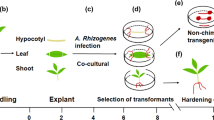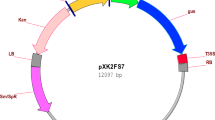Abstract
Plum plants were regenerated from hypo-cotyl segments derived from the embryonic axes of ungerminated seeds stored for up to six months at 4°C. Shoots were produced in 45 percent of the explants with an average of 8 shoots per explant. This regeneration system was used for Agrobacterium-mediated transformation with plasmids containing genes for neo-mycin phosphotransferase (NPTII) and β-glucuronidase (GUS). Approximately 25 percent of the explants produced shoots on regeneration medium in the presence of antibiotics, and 30 percent of these could be rooted. Putative transgenic plants expressed NPTII and GUS activity, and Southern analyses demonstrated integration of T-DNA into the plum genome.
This is a preview of subscription content, access via your institution
Access options
Subscribe to this journal
Receive 12 print issues and online access
$209.00 per year
only $17.42 per issue
Buy this article
- Purchase on Springer Link
- Instant access to full article PDF
Prices may be subject to local taxes which are calculated during checkout
Similar content being viewed by others
References
Filatti, J.J., Selmer, J., McCown, B., Haissig, B. and Comai, L. 1987. Agrobacterium-mediated transformation and regeneration of Populus. Mol. Gen. Genet. 206: 192–199.
McGranahan, G.H., Leslie, C.A., Uratsu, S.L., Martin, L.A. and Dandekar, A.M. 1988. Agrobacterium-mediated transformation of walnut somatic embryos and regeneration of transgenic plants. Bio/Technology 6: 800–804.
James, D.J., Passey, A.J., Barbara, D.J. and Bevan, M. 1989. Genetic transformation of apple (Malus pumila Mill) using a disarmed Ti-binary vector. Plant Cell Rep. 7: 658–661.
Fitch, M.M.M., Manshardt, R.M., Gonsalves, D., Slighton, J.L. and Sanford, J. 1990. Stable transformation of papaya via microprojectile bombardment. Plant Cell Rep. 9: 189–194.
Hammerschlag, F.A., Bauchan, G. and Scorza, R. 1985. Regeneration of peach plants from callus derived from immature embryos. Theor. Appl. Genet. 70: 248–251.
Mante, S., Scorza, R. and Cordts, J.M. 1989. Plant regeneration from cotyledons of Prunus persica, Prunus domestica and Prunus cerasus. Plant Cell Tissue and Organ Cult. 19: 1–11.
Lane, D.W. and Cossio, F. 1986. Adventitious shoots from cotyledons of immature cherry and apricot embryos. Can. J. Plant Sci. 66: 953–959.
Pieterse, R.E. 1989. Regeneration of plants from callus and embryos of ‘Royal’ apricot. Plant Cell Tissue and Organ Cult. 19: 175–179.
Meng, X. and Zhou, W. 1981. Induction of embryoid and production of plantlets in vitro from endosperm of peach. Acta. Agric. Univ. Peking. 7: 95–98.
Jones, O.P., Gayner, J.A. and Watkins, R. 1984. Plant regeneration from callus tissue cultures of the cherry rootstock Colt (Prunus avium x P. cerasus) and the apple rootstock M.25 (Malus pumila). J. Hort. Sci. 59: 463–467.
Ochatt, S.J., Cocking, E.C. and Power, J.B. 1987. Isolation culture and plant regeneration of Colt cherry (Prunus avium x pseudo cerasus) protoplasts. Plant Sci. 50: 139–143.
Mehra, A. and Mehra, P.N. 1974. Organogenesis and plantlet formation in vitro in almond. Bot. Gaz. 135: 61–73.
Druart, Ph. and Gruselle, R. 1986. Plum (Prunus domestica), p. 130–154. In: Biotechnology in Agriculture and Forestry, Vol. 1: Trees. Y. P. S. Bajaj (Ed.). Springer-Verlag, New York.
Comai, L., Moran, P. and Maslyar, D. 1990. Novel and useful properties of a chimeric plant promoter combining CaMV 35S and MAS elements. Plant Mol. Biol. 15: 373–381.
Langridge, W.H.R., Fitzgerald, K.J., Koncz, C., Schell, J. and Szalay, A.A. 1989. Dual promoter of Agrobacterium tumefaciens mannopine synthase genes is regulated by plant growth hormones. Proc. Natl. Acad. Sci. USA 86: 3219–3223.
Sanger, M., Daubert, S. and Goodman, R.M. 1990. Characteristics of a strong promoter from figwort mosaic virus: comparison with the analogous 35S promoter from cauliflower mosaic virus and the regulated mannopine synthase promoter. Plant Mol. Biol. 14: 433–443.
Murashige, T. and Skoog, F. 1962. A revised medium for rapid growth and bioassays with tobacco tissue cultures. Physiol. Plant. 15: 473–497.
O'Brien, T.P. and McCully, M.E. 1981. The Study of Plant Structure, Principles and Selected Methods. Termarcarphi Pty., Ltd., Melbourne, Australia.
Hood, E.E., Helmer, G.L., Fraley, R.T. and Chilton, M. 1986. The hypervirulence of Agrobacterium tumefaciens A281 is encoded in a region of PTiBo542 outside of T-DNA. J. Bact. 168: 1291–1301.
Bradford, M.M. 1976. A rapid and sensitive method for quantitation of microgram quantities of protein utilizing the principle of protein-dye binding. Anal. Biochem. 71: 248–254.
McDonnel, R.E., Clark, R.D., Smith, W.A. and Hinchee, M.A. 1987. A simplified method for the detection of neomycin phospho-transferase II activity in transformed plant tissues. Plant Mol. Biol. Rep. 5: 380–386.
Rao, R.N. and Rogers, S.G. 1979. Plasmid pKC7: a vector containing ten restriction endonuclease sites suitable for cloning DNA segments. Gene 7: 79–82.
Jefferson, R.A. 1987. Assaying chimeric genes in plants: The GUS gene fusion system. Plant Mol. Biol. Rep. 5: 387–405.
Scorza, R., Morgens, P.H., Cordts, J.M., Mante, S. and Callahan, A.M. 1990. Agrotocterium-mediated transformation of peach (Prunus persica L. Batsch) leaf segments, immature embryos, and long-term embryogenic callus. In Vitro Cell. Dev. Biol. 26: 829–834.
Maniatis, T., Fritsch, E.F. and Sambrook, J. 1982. Molecular Cloning, a Laboratory Manual. Cold Spring Harbor, N.Y.
Author information
Authors and Affiliations
Rights and permissions
About this article
Cite this article
Mante, S., Morgens, P., Scorza, R. et al. Agrobacterium-Mediated Transformation of Plum (Prunus domestica L.) Hypocotyl Slices and Regeneration of Transgenic Plants. Nat Biotechnol 9, 853–857 (1991). https://doi.org/10.1038/nbt0991-853
Received:
Accepted:
Issue Date:
DOI: https://doi.org/10.1038/nbt0991-853
This article is cited by
-
Prunus genetics and applications after de novo genome sequencing: achievements and prospects
Horticulture Research (2019)
-
Current achievements and future directions in genetic engineering of European plum (Prunus domestica L.)
Transgenic Research (2018)
-
A non-antibiotic selection strategy uses the phosphomannose-isomerase (PMI) gene and green fluorescent protein (GFP) gene for Agrobacterium-mediated transformation of Prunus domestica L. leaf explants
Plant Cell, Tissue and Organ Culture (PCTOC) (2017)
-
Can Prunus serotina be Genetically Engineered for Reproductive Sterility and Insect Pest Resistance?
Springer Science Reviews (2014)
-
Phosphomannose-isomerase as a selectable marker for transgenic plum (Prunus domestica L.)
Plant Cell, Tissue and Organ Culture (PCTOC) (2013)



